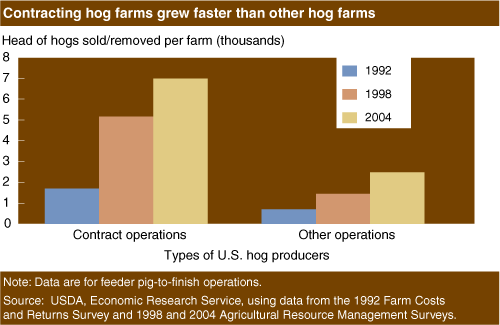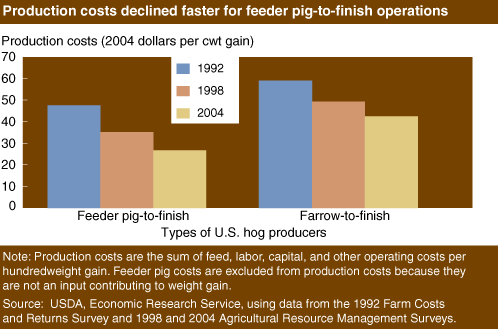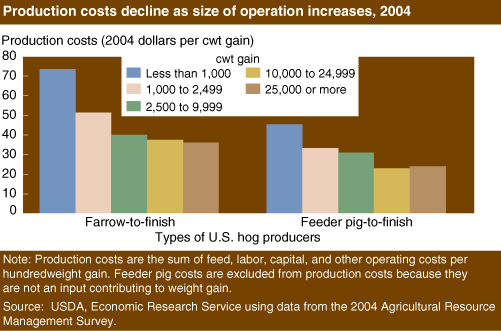Technology, Larger Farm Size Increased Productivity on U.S. Hog Farms
- by Nigel Key and William D. McBride
- 4/1/2008
Highlights
- U.S. hog production has shifted rapidly to fewer and larger operations that specialize in a single phase of production and use production contracts.
- Substantial productivity gains for hog farms, particularly specialized hog-finishing operations, have resulted in reduced costs of production and contributed to lower prices for hogs at the farmgate.
- Technological innovation and increasing farm size each explain about half the gains in hog farm productivity between 1992 and 2004.
Today’s hog sector bears little resemblance to the one that existed 15 years ago. There are fewer hog farms, and the average number of hogs per farm has increased substantially. Most production occurs under contracts with processors. Under those arrangements, processors supply feed, feeder pigs, and veterinary services to growers who receive a fee for providing the capital, utilities, and labor used to grow the hogs to market weight. Production contracts encourage individual producers to specialize in a single phase of production rather than combining all phases on one hog farm, as in the traditional farrow-to-finish approach. The past 15 years have also seen substantial geographical movement of production into States outside of the Corn Belt, especially North Carolina, Oklahoma, and Utah.
The structural transformation of the hog sector has been driven in part by technological advances in livestock genetics, nutrition, housing and handling equipment, veterinary and medical services, and management. These changes have contributed to large increases in hog-farm productivity, which have exerted downward pressure on hog and pork prices. As the industry has changed, hog producers have adjusted the size, organizational structure, and technological base of their operations to remain competitive. Recent ERS research combines information from surveys of hog producers at three points in time to document how the hog sector changed between 1992 and 2004 and to measure the level and sources of the hog-farm productivity gains.
Industry Scale and Specialization Increasing
Although the number of farms with hogs dropped over 70 percent from more than 240,000 in 1992 to fewer than 70,000 in 2004, the U.S. hog inventory remained stable at about 60 million head. Thus, hog production consolidated considerably during this period as fewer and larger farms accounted for an increasing share of total output. Although this is not unusual for U.S. livestock production, consolidation in hog production was among the most rapid of all livestock types.
The average size of U.S. hog operations grew from 945 head in 1992 to 4,646 head in 2004. The share of the hog inventory on operations with 2,000 or more head increased from less than 30 percent to nearly 80 percent, with operations having 5,000 or more head accounting for more than 50 percent of the hog inventory by 2004.
Traditionally, individual hog farms, known as farrow-to-finish operations, managed all phases of hog production from breeding to slaughter. Today, farrow-to-finish operations have given way to large operations that specialize in one of the three major life-cycle phases of production: farrow-to-wean, wean-to-feeder pig, or feeder pig-to-finish. In 1992, 65 percent of hogs came from farrow-to-finish operations, while only 22 percent came from specialized hog-finishing operations. By 2004, only 18 percent came from farrow-to-finish operations, while 77 percent came from specialized hog finishers.
Changes in scale and specialization have been made possible, in part, by substantial growth in the use of production contracts. Hog operations with production contracts grew from 5 percent of operations in 1992 to 67 percent in 2004. Production contracts govern the relationship between hog growers and owners (“integrators” or “contractors”), specifying the inputs provided by each party and their compensation. Because contractors typically provide feeder pigs and feed to growers and handle the marketing, such an arrangement facilitates growers’ specialization in one phase of production.
The increasing use of production contracts has also promoted farmers’ specialization in the hog enterprise. Because contractors supply feed from off-farm sources to their growers, individual growers can use their time and financial resources to increase the scale of hog operations rather than expand crop acreage to produce feed. Between 1992 and 2004, hog production as a share of the total production value on hog farms increased from 46 to 71 percent. At the same time, hog farms grew a smaller share of their hog feed: the share of grain produced on their farms for hog feed fell from about half to below 20 percent.
Farm Productivity Gains Mean Lower Production Costs
Hog farms, particularly the specialized feeder pig-to-finish operations that are more likely to use production contracts, showed large increases in productivity between 1992 and 2004 (see box, “How Do We Measure Productivity?”). The average quantity of feed required per hundredweight gain declined 44 percent for feeder pig-to-finish operations, and the average quantity of labor used fell 83 percent.
Farrow-to-finish operations exhibited smaller productivity gains than feeder pig-to-finish operations. For farrow-to-finish operations, the average quantity of feed required per hundredweight of gain declined by only 15 percent over the period, while the average quantity of labor used per hundredweight declined by 52 percent. The stronger productivity growth of feeder pig-to-finish operations, compared with farrow-to-finish operations, helps account for the growth in their share of finished hog output.
Productivity gains contributed to a decline in production costs between 1992 and 2004. For all farrow-to-finish hog producers, average production costs (in 2004 dollars) per hundredweight of gain were 28 percent lower in 2004 than in 1992. This change amounts to a 2.7-percent average annual rate of decline. Real costs declined faster for feeder pig-to-finish hog producers, falling 44 percent between 1992 and 2004, or 4.7 percent annually.
Structural change in the U.S. hog industry is the outcome of economic competition to increase farm productivity and lower production costs. If larger operations are more profitable than smaller ones, competitive pressures may be expected to result in a larger average farm size in the long run. Similarly, operations that are first to adopt a cost-saving technology, are in regions with lower input costs, or are closer to markets have a competitive advantage that makes them more likely to survive and grow. Business relationships between growers and processors also evolve to reflect productivity gains from increased specialization of the various phases of hog production on separate operations.
Technology and Structural Change Drive Farm Productivity Gains
Recent technological innovations, made possible in part by investments in research and development, include advances in genetics, nutrition, housing and handling equipment, veterinary and medical services, and management practices. The use of artificial insemination (AI) to improve genetic potential and conception rates has spread widely. According to the National Animal Health Monitoring System (NAHMS), 73 percent of sows were impregnated using AI by 2000, compared with only 1 percent in 1990. The use of “all-in/all-out” housing management, which commingles pigs of a similar age and weight and keeps the entire group together as it moves through each production phase, also increased from 25 percent of finishing-hog operations in 1990 to 57 percent in 2000 (accounting for about 85 percent of finished hogs produced). All-in/all-out management allows hog producers to tailor feed mixes to the age of their pigs (instead of offering either one mix to all ages or having to offer several different feed mixes at one time). All-in/all-out also helps limit the spread of infections to new arrivals by allowing for cleanup of the facility between groups of hogs being raised.
Specialized hog producers were more likely than farrow-to-finish operations to use innovative practices. Specialized farrowing operations used AI, commercial high-quality breeding hogs, and terminal crossbreeding—where all replacement females are purchased from outside suppliers—more often than farrow-to-finish operations. Specialized feeder pig-to-finish operations used phase feeding—where hogs or pigs are fed diets of varying protein and energy at different phases of life to match their changing nutritional requirements—and all-in/all-out management of finishing facilities more often than farrow-to-finish operations.
Larger hog operations tend to use more innovative technologies. In 2004, AI was used on only 4 percent of the farrow-to-finish operations with fewer than 500 head, but on 92 percent of operations with at least 5,000 head. Because large, specialized hog operations can spread fixed costs over more production and more easily take advantage of resulting productivity gains, they are better able to invest in current hog-production technologies. The survey data show increasing returns to scale—per unit production costs decline as the scale of production increases. With scale economies, farms should be able to reduce their unit costs as they expand. Then, as smaller farms leave the business and larger farms enter and expand further, industrywide costs should fall.
After analyzing the changes in hog farm productivity between 1992 and 2004, ERS estimates that almost all farm productivity gains could be attributed to increases in the scale of production and technological innovation, with each factor accounting for about half of the total increase in farm productivity over the period.
| Item | 1992 | 1998 | 2004 |
|---|---|---|---|
| Farm size (hogs sold/removed) | 804 | 2,756 | 4,730 |
| Productivity measures | |||
| Feed conversion rate (lbs per cwt gain) | 383 | 282 | 214 |
| Labor rate (hrs per cwt gain) | 0.89 | 0.24 | 0.15 |
| Source: USDA, Economic Research Service using data from the 1992 Farm Costs and Returns Survey and 1998 and 2004 Agricultural Resource Management Surveys. | |||
Productivity Gains Should Continue
ERS researchers estimate that relatively small productivity gains can be achieved solely by further increases in scale for the largest operations (operations with output of more than 25,000 hundredweight gain) using current technologies. However, for operations that produce less than an annual total of 25,000 hundredweight gain, there appears to be scope for future productivity gains in the hog-production sector from further increases in scale. Scale can be increased by smaller farms expanding or smaller farms being replaced by larger, new farms. In addition, the rate of technological innovation showed no signs of abating from 1998 to 2004, compared with 1992 to 1998. This suggests that new research and the adoption of more efficient methods of hog production will prolong the sector’s productivity gains into the foreseeable future.
This article is drawn from:
- Key, N. & McBride, W.D. (2007). The Changing Economics of U.S. Hog Production. U.S. Department of Agriculture, Economic Research Service. ERR-52.
You may also like:
- McBride, W.D. & Key, N. (2007). Characteristics and Production Costs of U.S. Hog Farms, 2004. U.S. Department of Agriculture, Economic Research Service. EIB-32.
- Decomposition of Total Factor Productivity Change in the U.S. Hog Industry. (2008). Journal of Agricultural and Applied Economics. Vol. 40, No. 1.
We’d welcome your feedback!
Would you be willing to answer a few quick questions about your experience?




